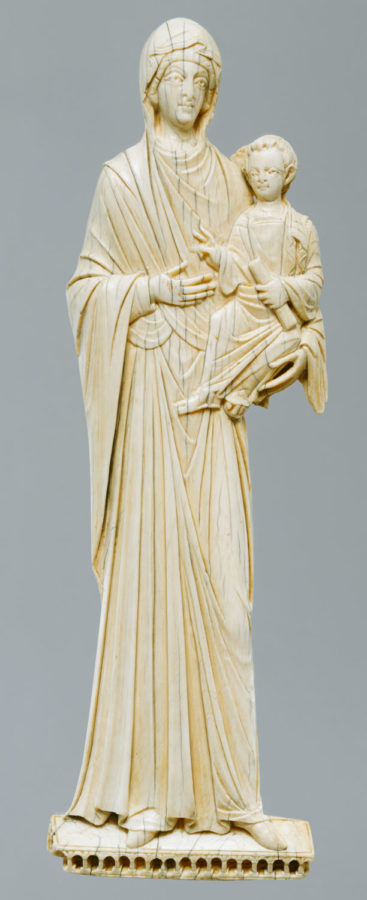In Medieval Art History the Word Icon Means
Byzantine icons are more of a prayer object than annihilation else. Though likened to idolatry, the icons mean more what tin can exist bars past that singular definition. Byzantine icons in the Medieval church were used to accompany prayers...to give the worshiper a two-dimensional paradigm, rather than a three-dimensional solid object, to use in their prayers.
They are not worshipping the object itself just the religious individual in the painting; or in the case of certain icons, an emperor. [caption id="attachment_19548" align="aligncenter" width="650"] Medallion with Christ from an Icon Frame, ca. 1100, Metropolitan Museum of Art, New York[/caption]
Medallion with Christ from an Icon Frame, ca. 1100, Metropolitan Museum of Art, New York[/caption]
What Are Byzantine Icons?
An icon is a work of art, typically of religious nature; derived from the Greek word eikōn,meaning 'prototype.' The near common icons are of religious figures: ranging from Christ, the Virgin Mary, saints, or angels. Furthermore, common icons are done in portrait manner, just also may include narratives, such every bit this ivory piece from ca. 2nd century from the Byzantine Empire. Though the setting effectually it is Spanish and completed at a subsequently date, the ivory centre itself is from Constantinople. [caption id="attachment_19750" marshal="aligncenter" width="720"]![]() Volume Embrace with Byzantine Icon of the Crucifixion, ca. 2nd Century CE, Metropolitan Museum of Art[/caption] The term 'icon,' more often than not refers to a specific manner of art from the Eastern Orthodox religion done in the style of a wooden panel painting; nonetheless, they came in multiple mediums and sizes - large, small, as jewelry, statues, church decorations, etc; and accept been dated back to the 8th century CE. [caption id="attachment_19549" align="aligncenter" width="1024"]
Volume Embrace with Byzantine Icon of the Crucifixion, ca. 2nd Century CE, Metropolitan Museum of Art[/caption] The term 'icon,' more often than not refers to a specific manner of art from the Eastern Orthodox religion done in the style of a wooden panel painting; nonetheless, they came in multiple mediums and sizes - large, small, as jewelry, statues, church decorations, etc; and accept been dated back to the 8th century CE. [caption id="attachment_19549" align="aligncenter" width="1024"]![]() Triptych Icon of the Virgin and Child with Saints, ca. 10th c., Walters Art Museum, Baltimore[/caption] This triptych icon of the Virgin Mary, child Christ, and saints portrays the Virgin pointing to her the Christ child with her hand. This gesture is known as "she who points the fashion," or the Virgin Hodegetria. The name stems from a specific icon which was located in the Hodegon Monastery in Constantinople. Compositionally, the three distinct pieces practise not match up. Art historians to believe the pieces were fitted together from two unlike artworks at a after date. While the pieces may non exactly match, this ivory and bone icon is a lasting example of the Byzantine mode. Beneath, the Virgin Mary points to her Child over again. This is, yet, much more of a stand up lone piece. [caption id="attachment_19551" align="aligncenter" width="367"]
Triptych Icon of the Virgin and Child with Saints, ca. 10th c., Walters Art Museum, Baltimore[/caption] This triptych icon of the Virgin Mary, child Christ, and saints portrays the Virgin pointing to her the Christ child with her hand. This gesture is known as "she who points the fashion," or the Virgin Hodegetria. The name stems from a specific icon which was located in the Hodegon Monastery in Constantinople. Compositionally, the three distinct pieces practise not match up. Art historians to believe the pieces were fitted together from two unlike artworks at a after date. While the pieces may non exactly match, this ivory and bone icon is a lasting example of the Byzantine mode. Beneath, the Virgin Mary points to her Child over again. This is, yet, much more of a stand up lone piece. [caption id="attachment_19551" align="aligncenter" width="367"] Icon with the Virgin and Child, ca. mid tenth-11th c., Metropolitan Museum of Fine art, New York[/explanation]
Icon with the Virgin and Child, ca. mid tenth-11th c., Metropolitan Museum of Fine art, New York[/explanation]
The Good and the Bad of Byzantine Icons Throughout History
In the Byzantine church, the icon was used for contemplation of prayer to be used as a method of straight communication with the religious figures. And while there are many left to admire from the Byzantine Empire menses, there have been many acts of unrest confronting much more pieces than we know virtually.
Iconoclasm
Iconoclasm is defined every bit 1) the action of attacking or assertively rejecting cherished beliefs and institutions or established values and practices as well every bit ii) the rejection or destruction of religious images as heretical; the doctrine of iconoclasts. At that place has been more than than one episode of iconoclasm within history and the Christian church; information technology is non an bibelot to the Byzantine or Orthodox civilization(s). Relating to the Byzantine, or Eastern Orthodox church building, is the iconoclast movement of "breaking images" due to the theological debates between the Byzantine state and Orthodox church. Considering of the span of years where icons were not allowed to exist produced or used in worship, not many even so exist. Whether they were destroyed or painted over, the controversy was not without the loss of beautiful works of art. Neither icons of religious and figures or heads of country were safe from destruction. It still occurs today; when new political regimes accept over, they tend to destroy the iconic images from the previous political or religious grouping(s). It is happening in the Middle East and fifty-fifty the United States where statues dedicated to Ceremonious-State of war faction leaders are torn down because of the ideas they stand for regarding racism and slavery.
Learn more:
[easyazon_image align="none" height="110" identifier="2503544045" locale="US" src="https://www.dailyartmagazine.com/wp-content/uploads/2019/03/41YW9teAWRL.SL110.jpg" tag="dailyartdaily-twenty" width="73"] [easyazon_image align="none" meridian="110" identifier="1853997501" locale="The states" src="https://www.dailyartmagazine.com/wp-content/uploads/2019/03/51TNwXmhYJL.SL110.jpg" tag="dailyartdaily-20" width="73"]
Source: https://www.dailyartmagazine.com/byzantine-icons-the-who-what-when-and-where/
Post a Comment for "In Medieval Art History the Word Icon Means"